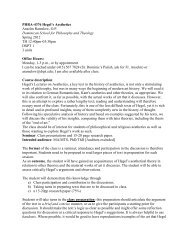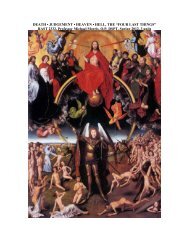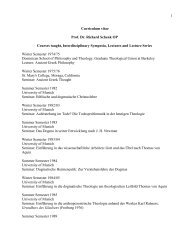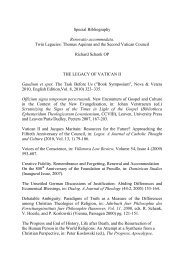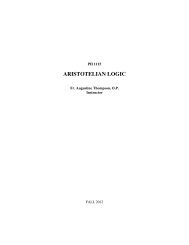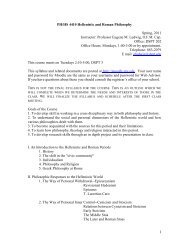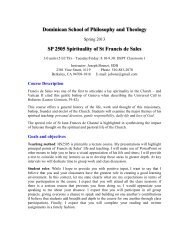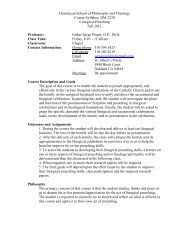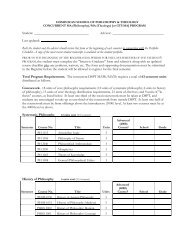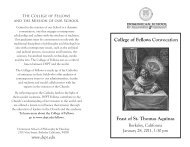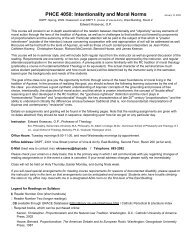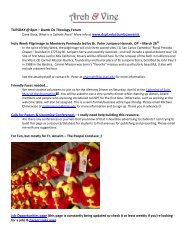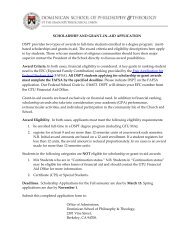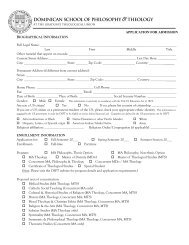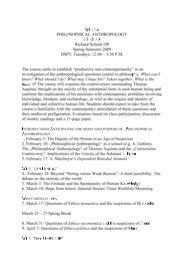READINGS for HS 4476 MEDIEVAL HERETICS AND INQUISITORS
READINGS for HS 4476 MEDIEVAL HERETICS AND INQUISITORS
READINGS for HS 4476 MEDIEVAL HERETICS AND INQUISITORS
You also want an ePaper? Increase the reach of your titles
YUMPU automatically turns print PDFs into web optimized ePapers that Google loves.
INQUISITION DOCUMENTS 22<br />
from the secular courts. Torture became regularized in ecclesiastical counts about the year 1300.<br />
The courts did have other means of "encouraging" confessions, imprisonment <strong>for</strong> example.<br />
Alarassi Biasse<br />
4 Translated from the "Collection Doat"; documents published as an appendix in Raoul Manselli, Spirituali e beghini in<br />
Provenza (Rome, 1959).<br />
TEXTS ON POVERTY HERESIES 4<br />
Translated by Prof. David Burr<br />
DEPOSITIONS CONCERNING FRATICELLI <strong>AND</strong> BEGUINES<br />
Toulouse, 1320s<br />
Alarassi Biasse of Sauvian in the diocese of Béziers, niece of Friar Pierre Déjean Olieu [Peter<br />
John Olivi] <strong>for</strong>merly of the Franciscan order, as we legally learned through her confession made<br />
during judgment, received in her house two Franciscans of whom she gives the names. They had first<br />
been at her house in Franciscan habits, then in secular clothing, more precisely in blue clothing worn<br />
over their Franciscan habits. These friars told her that they were traveling in secular clothing because<br />
they did not want to go to the far-off convents where they had been sent by their ministers, having<br />
looked and the sealed letters they bore with them and discovered that they contained orders to<br />
imprison them once they arrived. They said that six of them had been staying together at a hostel in<br />
Toulouse, which they did not identify.<br />
Again she said that these two friars, one of whom was a relation of hers, stayed in her home<br />
dressed in secular garb from Easter into the month of June, just after the wheat was harvested. She<br />
and her mother provided <strong>for</strong> their needs. She added that two other apostate friars of the Franciscan<br />
order, whom she named, came to her house dressed in blue clothing and visited the first two. They<br />
stayed in the house with them, wearing secular clothing over their Franciscan habits. She gave one<br />
of them four canne of blue cloth out of which he made a tunic. Later they returned to Toulouse,<br />
where, as has been said, the six had stayed together <strong>for</strong> some time disguised as seculars.<br />
Again, she received in her home and gave drink to two men who said they had come from<br />
Sicily in search of the a<strong>for</strong>esaid apostate Franciscans who did not dare to go about or show<br />
themselves in public. Their aim was to bring these friars to Sicily. In order to discern whether she<br />
could trust these two men enough to reveal the presence of the a<strong>for</strong>esaid friars, who were then hiding<br />
in her solar, she went to Toulouse and consulted Pierre Trencavel. He replied that she could trust the<br />
two and that the hidden friars could confidently leave and cross the sea with them. Once she had<br />
heard this, she returned to Sauvian and relayed all that she had learned from Pierre Trencavel to the<br />
fugitive friars. Fifteen days later the two men returned with a boat and came to her house. Later four<br />
more friars (whom she named) arrived and on a certain Saturday night all six friars boarded the boat<br />
along with the two men and they all left. Once they arrived in Majorca two of the friars returned to<br />
Sauvian and told her all that had occurred.



